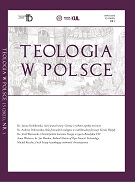W obecnym czasie pojawia się wiele negatywnych zjawisk w przestrzeni życia sakramentalnego, które świadczą o zaburzonej relacji pomiędzy życiem wiary a sakramentami. Z jednej strony w świecie zachodnim widzimy spadek liczby wiernych przystępujących do sakramentów. Z drugiej zaś strony sama praktyka sakramentalna w świecie zachodnim często nie jest świadomym wyrażaniem wiary. Widać dziś w związku z tym wiele niedostatków zarówno na płaszczyźnie fides qua, jak i na poziomie fides quae. Dlatego właśnie wyjaśnienie relacji pomiędzy wiarą a sakramentami staje się obecnie zadaniem szczególnie pilnym. Z tematem tym powinniśmy się zmierzyć w kontekście współczesnego Kościoła, ale w świetle jego Tradycji. Przede wszystkim pożyteczne jest przeanalizowanie pod tym kątem dzieł ojców Kościoła (por. części I, II i III). Ojcowie są świadkami wiary z pierwszych wieków, ulokowanymi w nurcie żywej Tradycji, sięgającej apostołów. W swoim nauczaniu łączyli oni przesłanie Biblii, teologię, liturgię oraz życie duchowe i duszpasterstwo w ramach jednej syntezy, poprzez którą ich teksty mogą służyć także nam i Kościołowi trzeciego tysiąclecia. Pristina Sanctorum Patrum norma (KL 50) powinna zostać przyjęta także dziś jako zasada inspirująca Kościół. Również synteza scholastyczna (Tomasz z Akwinu) pomaga nam odpowiedzieć na wywołane pytanie. W wyjaśnieniu Tomasza znajdujemy klarowną tezę, będącą punktem wyjścia: „Kościół jest zbudowany na wierze i jej sakramentach” – gdzie wprost mowa jest o sakramentach jako sacramenta fidei. Trzeba także odwołać się do reformacji oraz nauczania Soboru Trydenckiego. Zobaczymy wówczas, że historyczna analiza relacji pomiędzy wiarą a sakramentami pomoże nam odpowiedzieć na pytania nurtujące Kościół w naszych czasach. W konkluzji poddany analizie został 59 punkt konstytucji Sacrosanctum concilium.
SUMMARY
There are many negative phenomena in the sacramental life which point out to a disturbed relationship between lived faith and the sacraments. On one hand, we see a growing decrease of attendance to the sacraments in the western world. On the other hand, the sacramental practice in the western world is often not a conscious expression of faith. We see many flaws from the point of view of the fides qua and from that of the fides quae as well. The explanation of the faith-sacraments relationship has become an urgent question. We should deal with the topic in the actual context of the Church, but in the light of the Church’s tradition. First of all it is very useful to analyze the works of the Fathers (cfr. chapters I, II, III). The Fathers are witnesses of the faith of the first centuries vitally inserted in the tradition which derives from the Apostles. In fact they have joined together sacred scripture, theology, liturgy, spiritual and pastoral life in a vital unity through which their works can help us and also the Church of the third millenium. The pristina Sanctorum Patrum norma (cfr. SC 50) is to be considered the norm and the inspiring rule for the Church of today as well. Also the scholastic synthesis (Thomas Aquinas) helps us to give an answer to our main question. In the explanation of St. Thomas we find a clear thesis as a point of departure: “The Church is founded upon faith and its sacraments”, and expressly qualifies the sacraments as sacramenta fidei. We should also know the Reformation and the teaching of the Council of Trent. We will see that the historic analysis of the relationship between faith and the sacraments helps us to find the answer to the subject of the Church’s problem in our days. As a final conclusion it is worth analyzing the Sacrosanctum concilium n. 59.
Ostatnia aktualizacja: 28.02.2020, godz. 08:09 - Marcin Walczak































